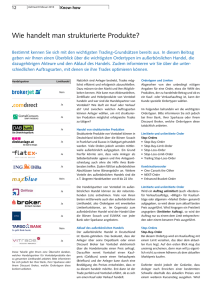Buy a Reverse Convertible, an Auto-call, a Shark Note, a Bonus Certificate, the structured products market contains as many structured products and payoffs as there are risks. To see more clearly, structured products are generally classified into four main categories. What are they? The Strukturierte Produkte .
A structured product, a function of risk and return
To understand how structured products are categorized, one must first look at two things. First, in what proportion the investor sees his capital protected at maturity. Then, what risk does the optionality contained within this structured product run the investor is long or short of an option? What leverage? What type of observations? From there, we can identify these four main categories.
Capital protection

Guaranteed or protected capital products concern these structures where the repayment of capital at maturity is guaranteed, apart from the issuer risk, while giving a certain exposure to the performance of the underlying asset.
Because the investor takes relatively little risk through this type of structured product, the expected return is also low. Generally, capital-guaranteed products give exposure to low volatility underlying or a basket of underlying. Their performance should be compared to other products with a similar risk or return profile, such as bonds.
Note that a guaranteed capital is not necessarily 100% guaranteed. The guarantee level can be set at 97%, 95%, etc. As for participation in performance, this may very well be participation in positive, negative performance, conditional coupons, etc. Among the guaranteed capital products, we can find for example Bonds + Call, Bonds + Call up & out or Shark Note, Bonds + Put, Phoenix Auto-call with conditional coupons.
Performance optimization
Performance optimization products concern these structures where the repayment of capital at maturity is not guaranteed, where participation in positive performance is limited, but where participation in negative performance may be entirely under certain conditions, all within the goal of obtaining a higher yield.
Because the investor takes relatively more risk through this type of structured product, the expected return is also higher. Generally, performance-optimized products give limited exposure to an underlying asset or basket of underlying assets in the event of good performance, but total exposure in the event of very poor performance. Traditionally, these structured products involve being short of a Vanilla Put or a Putdown & In. The investor can only earn more than the premium he pockets but can lose all of his capital. Among the products with performance optimization, we can find Reverse Convertible mono or worst off, Bonus Capped Certificates, Express Certificates or Auto-call.
Participation
Equity products relate to these structures where the repayment of capital at maturity is only little guaranteed, where participation in positive performance is generally included, sometimes even with leverage.
Because the investor takes significant risks through this type of structured product, the expected return is also high. Generally, participating products give full exposure or even more than 1 in case of good performance, or guarantee a minimum of performance in favorable cases. Among the participating products, we can find trackers, Outperformance Certificates, Bonus Certificates, Twin-Win.
The sink
Leverage products concern these structures where the repayment of capital at maturity is not guaranteed, unless there is a stop loss or knock out, and where the participation in the performance of the underlying asset can be greater than 1.

